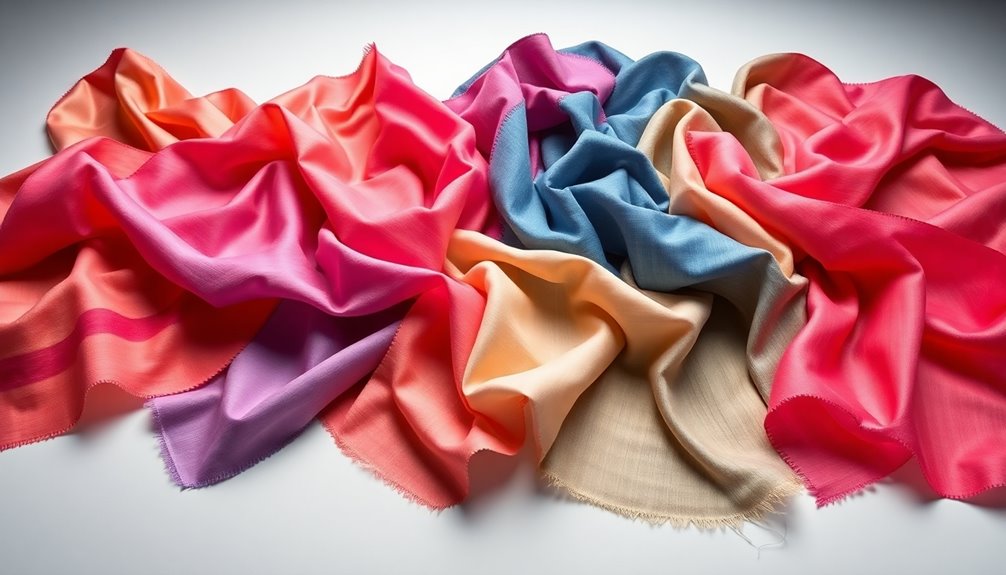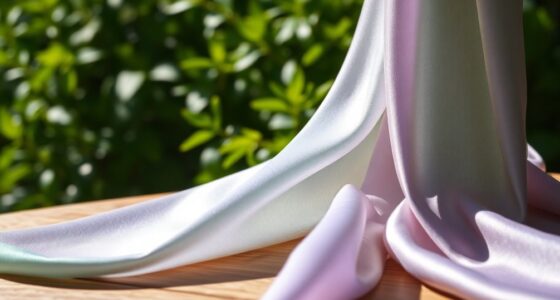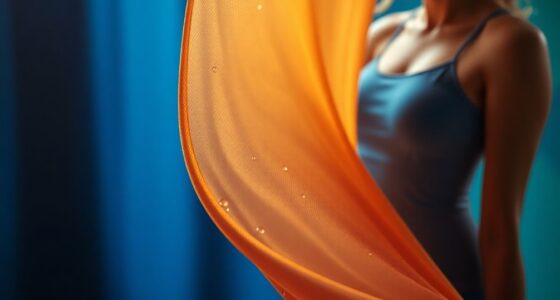As we approach 2025, eco-friendly fabrics are set to dominate the market. With 66% of consumers willing to pay more for sustainable options, materials like organic cotton, recycled polyester, and innovative textiles made from mycelium or algae are gaining traction. Performance fabrics are also evolving, offering moisture management and durability. Choosing the right fabric means balancing sustainability with style and function. Discover how emerging trends could shape your fabric choices in the years ahead.
Key Takeaways
- Sustainable fabrics like organic cotton and recycled polyester are projected to dominate due to rising consumer demand for eco-friendly options.
- Smart textiles with integrated sensors for health monitoring will become increasingly popular in performance wear by 2025.
- Innovations in biodegradable synthetic fibers, like Tencel, will lead to a significant shift towards environmentally friendly alternatives in the market.
- Natural fibers such as linen and hemp will gain traction for their durability and low environmental impact, appealing to conscious consumers.
- The intersection of technology and sustainability will redefine fabric choices, prioritizing performance while minimizing environmental harm.
The Evolution of Fabric Technology

As fabric technology evolves, you're witnessing a revolution in how textiles interact with our lives. Smart textiles are at the forefront, integrating sensors to monitor your body temperature, heart rate, and movement, enhancing comfort and functionality.
Innovations in sustainable materials, like bio-fabricated textiles from mycelium and algae, aim to reduce environmental impact, making your wardrobe more eco-friendly.
The rise of 3D printing allows for intricate designs while minimizing waste, letting you enjoy personalized fashion without guilt.
Nanotechnology boosts fabric properties, offering water resistance, stain repellence, and antimicrobial effects, leading to garments that last longer.
With advances in dyeing and finishing, eco-friendly practices are becoming standard, ensuring that your clothing choices contribute positively to the planet.
Sustainable Fabrics: A Growing Trend
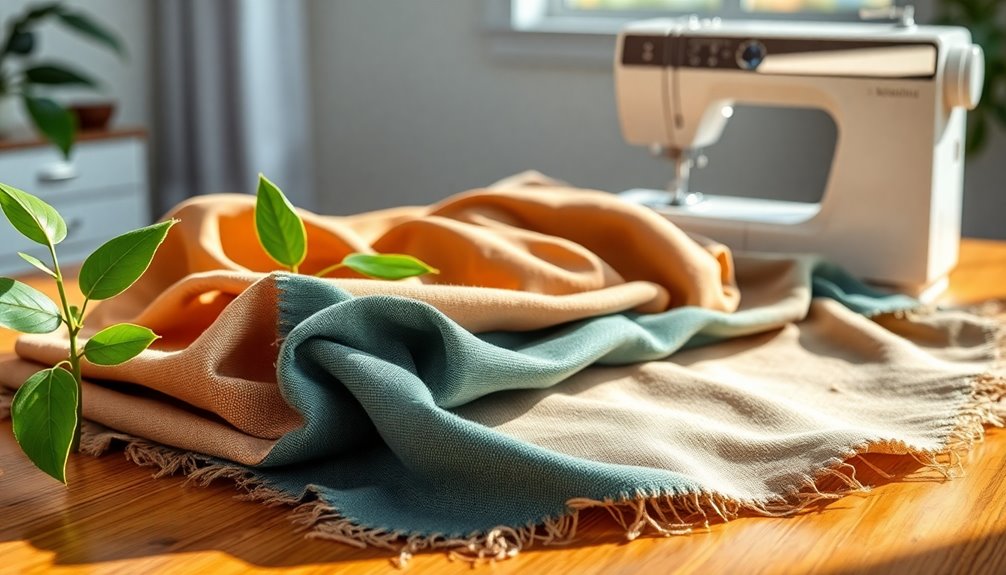
The shift towards sustainable fabrics reflects a growing awareness of environmental issues among consumers. With 66% of global consumers willing to pay more for eco-friendly brands, materials like linen and organic cotton are gaining traction. Linen, derived from the flax plant, boasts low water usage and minimal chemical inputs, making it incredibly eco-friendly. Similarly, organic cotton is favored for its lack of synthetic pesticides and fertilizers. Innovations in fabric recycling have also led to the rise of recycled polyester, further reducing environmental impact. The sustainable fashion movement emphasizes durability and circular economy principles, encouraging upcycling and leasing. Additionally, the integration of energy-efficient technology in the production processes of sustainable fabrics can further enhance their environmental benefits.
| Fabric Type | Features |
|---|---|
| Linen | Low water usage, minimal chemicals |
| Organic Cotton | Grown without synthetic chemicals |
| Recycled Polyester | Made from post-consumer waste |
Performance Fabrics: Redefining Functionality
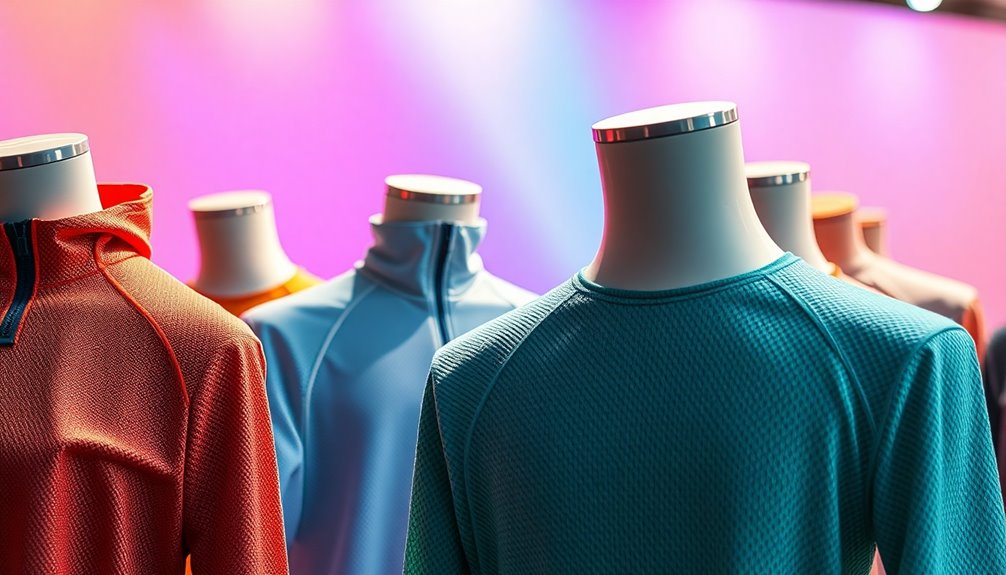
When it comes to performance fabrics, moisture management is key to keeping you comfortable and dry during your activities.
Innovations in sustainable fabrics aren't only enhancing function but also reducing environmental impact, allowing you to feel good about your choices.
As you explore your options, you'll find that these advancements are changing the game for activewear and outdoor gear.
Moisture Management Technologies
Moisture management technologies in performance fabrics are revolutionizing how you experience physical activities by keeping you dry and comfortable. With advanced moisture-wicking capabilities and breathability, these fabrics use hydrophobic and hydrophilic fibers to pull sweat away from your skin, enhancing comfort during workouts. Innovations like nano-coatings and antimicrobial treatments reduce odors, while seamless 3D knitting boosts ventilation. Testing shows these performance fabrics can lower skin temperature by up to 2 degrees Celsius, optimizing temperature regulation during intense activities.
| Feature | Benefit | Impact on Experience |
|---|---|---|
| Moisture-wicking | Stays dry | Increased comfort |
| Breathability | Enhanced airflow | Better performance |
| Temperature regulation | Cooler workouts | Prolonged endurance |
Sustainable Fabric Innovations
As consumers increasingly prioritize eco-friendly choices, sustainable fabric innovations are transforming the performance wear industry. Brands are now leveraging recycled materials and eco-friendly production processes, like turning post-consumer plastic bottles into performance fabrics.
These fabrics are moisture-wicking and breathable, ensuring you stay comfortable during workouts while being environmentally responsible. Many manufacturers are incorporating biodegradable elements, allowing fabrics to break down more easily in landfills, reducing long-term waste.
The advancements in fabric technology also mean that these performance fabrics can resist water and stains, with added natural antimicrobial properties.
With a projected compound annual growth rate of over 10% by 2025, the market for sustainable performance fabrics is booming, offering you stylish options that don't compromise on functionality or sustainability.
Natural vs. Synthetic: The Fabric Dilemma
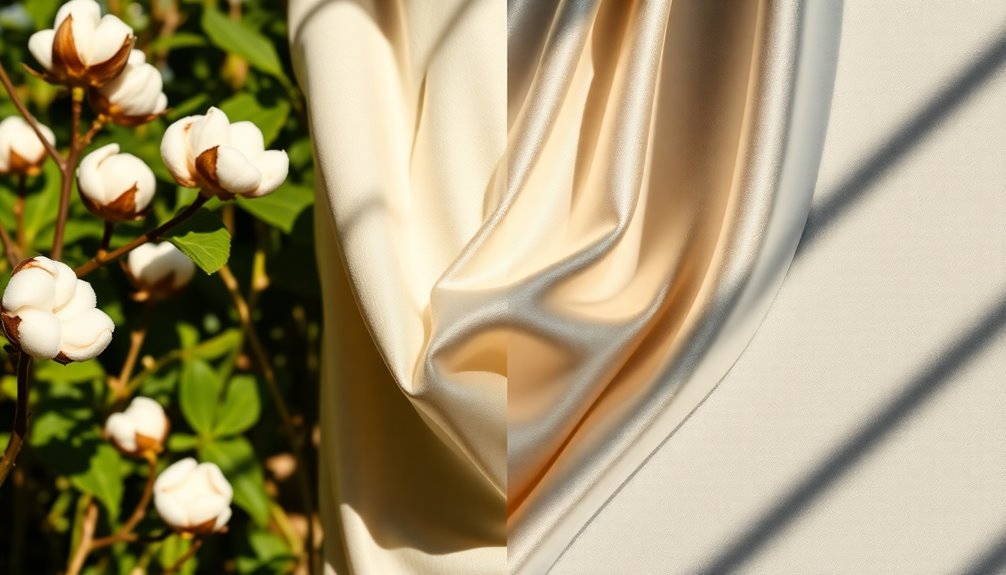
How do you choose between natural and synthetic fabrics in a world increasingly concerned with sustainability? You'll want to weigh the benefits of each type. Natural fibers like linen and cotton are often more breathable and eco-friendly, while synthetic fabrics such as rayon and polyester offer durability and vibrant colors. Here's a quick comparison:
| Fabric Type | Benefits | Drawbacks |
|---|---|---|
| Natural Fibers | Breathable, eco-friendly | Durability may vary |
| Linen | Moisture-wicking, durable | Higher cost |
| Cotton | Soft, biodegradable | Requires more water |
| Synthetic Fabrics | Durable, vibrant colors | Less breathable, less eco-friendly |
| Rayon | Soft texture | Environmental impact |
Ultimately, your choice will depend on your priorities regarding comfort, sustainability, and convenience.
The Role of Consumer Preferences in Fabric Selection
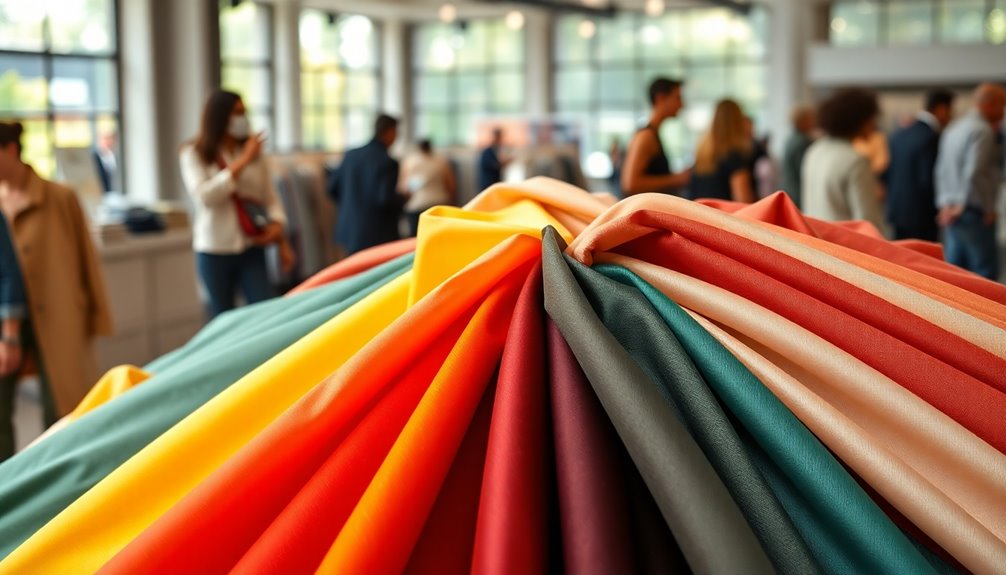
When it comes to choosing fabrics, your preferences are shaped by a mix of sustainability, comfort, and aesthetics.
You might find yourself drawn to eco-friendly options that feel good against your skin, while also considering the price tag.
Understanding how these factors play into your decisions can help you make smarter choices in the fabric marketplace.
Sustainability in Fabric Choices
While many consumers may still prioritize style and price, an increasing number are recognizing the importance of sustainability in their fabric choices.
You might find yourself drawn to sustainable fabrics like linen and organic cotton, both known for their lower environmental impact compared to conventional options.
With the global market for sustainable textiles projected to reach $8.25 billion by 2025, it's clear that consumer preferences are shifting.
Approximately 60% of shoppers are willing to pay more for eco-friendly fabrics, showing a commitment to environmental responsibility.
Brands that emphasize sustainable fabric choices often gain higher customer loyalty, as you and others appreciate companies that align with your values.
Ultimately, your choices can promote a more sustainable textile industry. Additionally, the rising demand for sustainable products in various sectors, including tea, reflects a broader trend towards environmental consciousness.
Comfort vs. Aesthetic Appeal
Balancing comfort and aesthetic appeal often defines your fabric selection process. You tend to prioritize comfort, gravitating toward breathable materials like linen and organic cotton, especially in warm climates.
These fabrics not only offer moisture-wicking abilities but also align with eco-conscious values. However, you can't ignore the allure of luxurious options like silk, which, despite their higher cost and care needs, provide unmatched softness and sheen.
As fashion trends evolve, unique textures and patterns from fabrics like viscous rayon catch your eye, emphasizing aesthetic appeal in your choices.
Ultimately, your decision hinges on finding that sweet spot where comfort meets visual elegance, shaping the way you express your personal style through fabric. Additionally, considering the importance of regular physical activity can enhance your overall well-being, influencing your fabric preferences for activewear.
Price Sensitivity and Value
As you navigate the fabric selection process, price sensitivity often influences your choices considerably. You might find yourself weighing affordability against durability and maintenance needs. Sustainable, eco-friendly materials like linen are gaining traction, particularly because they're often more budget-friendly than luxurious options like silk.
Here's a quick comparison to help you decide:
| Fabric Type | Price Range |
|---|---|
| Linen | Low |
| Cotton | Low |
| Durable Fabrics | Moderate |
| Silk | High (2-5x Linen) |
| Eco-friendly | Varies (often Low) |
Ultimately, understanding consumer preferences will guide you in selecting a fabric that balances cost with quality and environmental responsibility. Additionally, incorporating anti-aging drinks into your lifestyle can complement the choice of sustainable fabrics by promoting overall health and vitality.
Innovations in Eco-Friendly Textiles
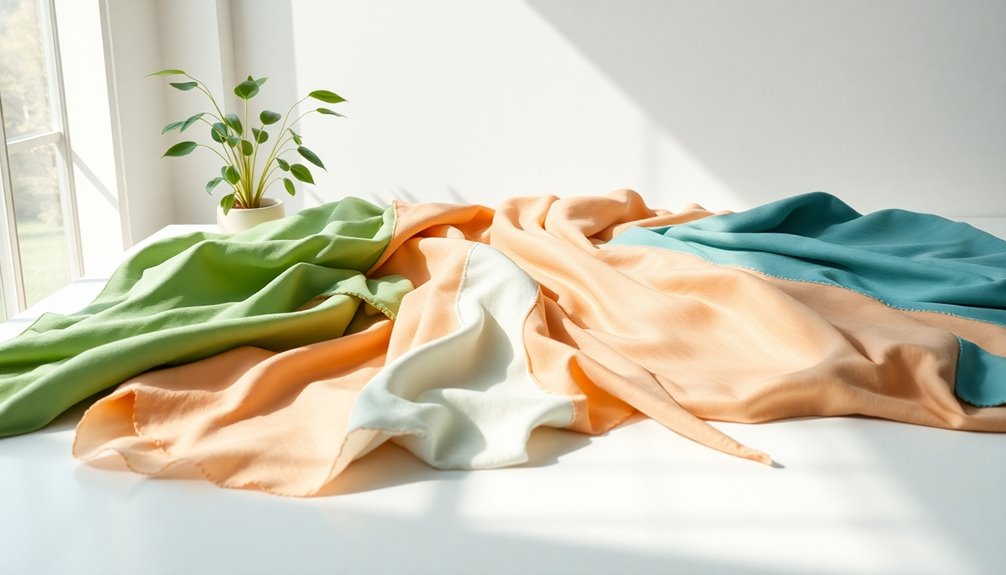
Innovations in eco-friendly textiles are reshaping the fashion industry by prioritizing sustainability without sacrificing style.
You'll find sustainable materials like organic cotton and linen, which use less water and chemicals during production. Biodegradable synthetic fibers, such as Tencel, are gaining traction for their eco-friendly closed-loop manufacturing process.
Plant-based alternatives like hemp and bamboo are perfect choices due to their rapid growth and minimal resource needs.
Furthermore, the rise of recycled materials, including fabrics made from post-consumer plastic bottles, helps tackle waste and reduces the demand for virgin resources.
Finally, innovations in dyeing processes, such as waterless dye technologies and natural dyes, are cutting down on water pollution, making eco-friendly textiles not just a trend but a necessity.
The Impact of Fast Fashion on Fabric Choices
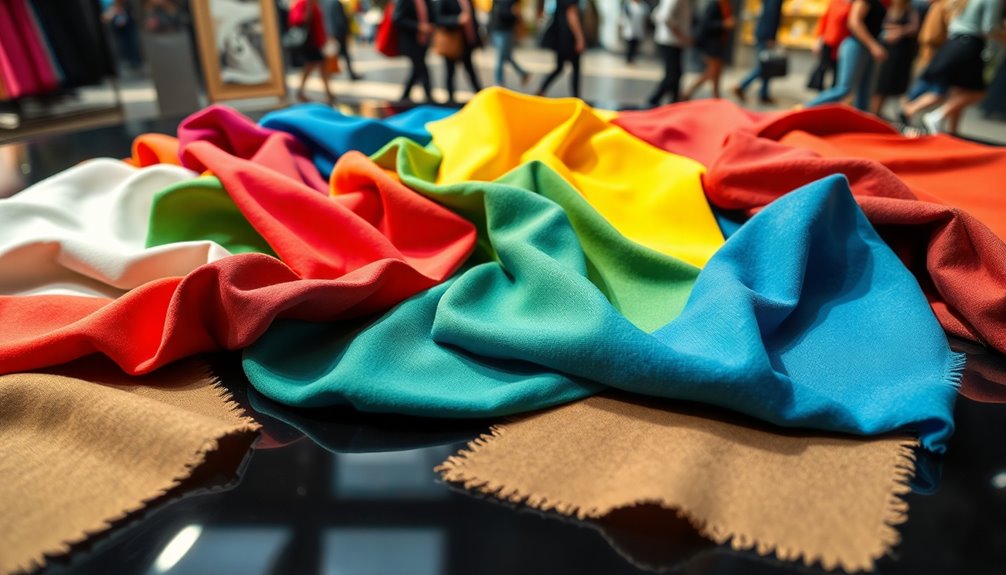
While fast fashion has revolutionized the way we shop, it's come at a steep cost to our environment and fabric choices. The surge in synthetic fabric production has overshadowed natural fibers, leading to significant environmental impact.
Consider these factors:
- Polyester accounts for over 60% of global fiber use.
- The average consumer buys 60% more clothing than in 2000.
- Around 92 million tons of textiles are discarded annually.
- Fast fashion prioritizes cheap, non-biodegradable materials.
- 66% of consumers now prefer to pay more for sustainability.
As awareness grows, the demand for eco-friendly fabric choices is rising. Innovations in renewable energy technologies are also essential for making sustainable fabric production more feasible and efficient.
We must shift towards sustainable materials like cotton and linen to reduce waste and protect our planet.
Future Trends in Fabric Production
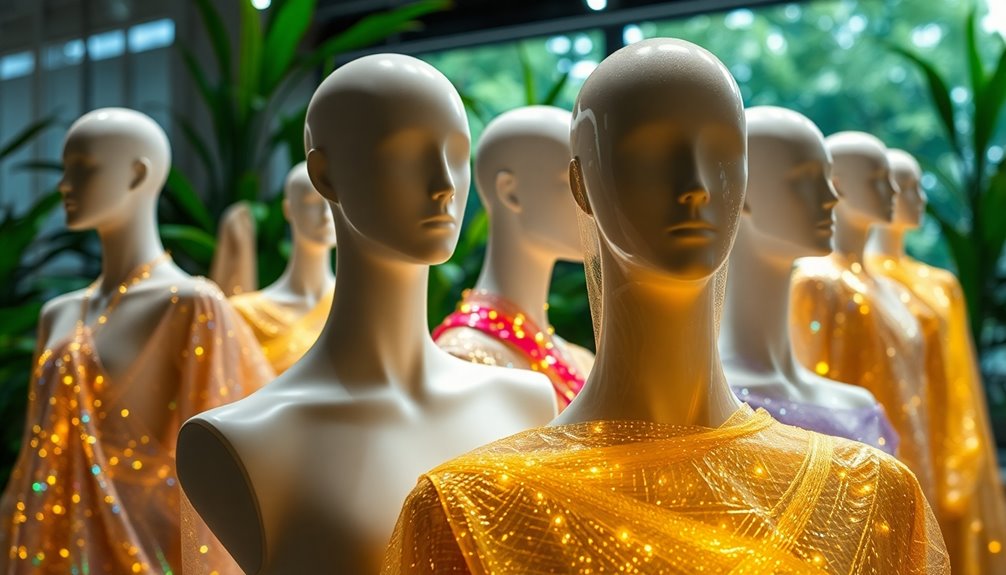
Sustainable fabric production is set to transform the fashion industry in the coming years, driven by growing consumer demand for eco-friendly materials.
You'll see a significant rise in sustainable fabrics like linen and organic cotton, as they offer a lower environmental impact.
Advances in technology are paving the way for innovative fabrics, including bioengineered textiles that combine durability with natural aesthetics.
The circular economy is pushing the global market for recycled fabrics, emphasizing waste reduction and material reuse.
Additionally, multifunctional fabrics are gaining popularity, featuring moisture-wicking and temperature regulation properties that cater to performance-oriented consumers.
As these trends unfold, expect a more responsible and efficient approach to fabric production in the near future.
Balancing Style and Practicality in Fabric Selection

When you're picking fabrics, it's essential to balance style with functionality.
You want materials that not only look good but also fit your lifestyle and care routine.
Consider how easy the fabric is to maintain and how it performs in your daily environment.
Style Versus Functionality
Choosing the right fabric involves more than just picking a trendy pattern; it's about finding that sweet spot where style meets practicality.
You want to take into account both aesthetics and functionality, ensuring your choices enhance your wardrobe while serving everyday needs.
Think about fabrics that deliver on both fronts:
- Breathability and moisture-wicking properties for comfort in warm weather
- Luxurious fabric like silk for special occasions
- Durable cotton for long-lasting everyday clothing
- Lightweight linen for effortless style and temperature regulation
- Soft rayon for a silky touch, but remember the maintenance!
Balancing style versus functionality means selecting materials that boast exceptional quality while still being practical, so you can look great and feel comfortable all day long. Additionally, consider fabrics with moisture retention properties that can enhance comfort in various environments.
Fabric Care Considerations
While selecting stylish fabrics is important, understanding how to care for them is equally essential for maintaining their appearance and longevity.
Linen bedding is durable and easy to care for, but it may require ironing to smooth out natural wrinkles. On the other hand, cotton is a natural choice that's machine washable and generally easy to care for, though it can shrink and wrinkle if mishandled.
Silk, while luxurious, requires more care, needing gentle hand washing or dry cleaning to preserve its sheen.
When considering the production process, organic cotton offers a sustainable option, avoiding harmful chemicals, while linen is environmentally friendly, using minimal water and pesticides.
Balancing style with practical fabric care will lead to longer-lasting materials. Additionally, understanding the lifespan perspective on fabric maintenance can help you make informed choices that enhance durability.
The Economic Factors Influencing Fabric Choices

As consumers evaluate their fabric choices, the economic factors at play greatly shape their decisions. You might consider:
- Cost: Linen's affordability compared to luxury silk, which can be 2 to 5 times pricier.
- Sustainability: Linen's lower water usage and fewer chemicals attract environmentally conscious buyers.
- Quality: High-quality silk offers softness, appealing to those seeking luxury.
- Ethical concerns: The impact of silk production on silkworms can sway preferences toward humane options like linen.
- Trends: The rise of eco-friendly materials pushes many to choose organic cotton and linen.
Ultimately, understanding these economic factors helps you make informed, sustainable fabric choices that align with your values and budget.
Frequently Asked Questions
What Are the Health Implications of Different Fabric Materials?
When you consider the health implications of different fabric materials, it's vital to look at factors like breathability, allergies, and chemical treatments.
Natural fabrics like cotton and linen are generally safer, reducing irritation and allergic reactions.
Synthetic materials may contain harmful chemicals that can affect your skin.
You should also be mindful of how fabrics are treated, as some dyes and finishes can cause health issues.
Prioritizing safe materials is important for your well-being.
How Do Fabric Production Methods Affect Local Economies?
When you consider fabric production methods, you'll notice they greatly impact local economies.
Sustainable practices often create jobs within communities, boosting employment and supporting local businesses. If producers prioritize eco-friendly methods, they might attract consumers who value ethical production, leading to increased demand.
Conversely, unsustainable practices can harm local environments and economies, driving away potential revenue.
Ultimately, your choices as a consumer can shape these outcomes and influence the economic landscape.
What Role Do Fashion Influencers Play in Fabric Trends?
Did you know that 70% of consumers trust influencers' opinions when it comes to fashion choices?
Fashion influencers play an essential role in shaping fabric trends. They showcase new materials on social media, sparking interest and driving demand.
How Can Consumers Identify Quality Fabrics When Shopping?
When you're shopping for quality fabrics, start by feeling the material. A good fabric should feel soft and have a certain weight to it.
Check the stitching—tight, even stitches indicate better craftsmanship.
Look for natural fibers like cotton or wool, as they tend to breathe better and last longer.
Finally, don't forget to read care labels; they can reveal a lot about the fabric's durability and maintenance requirements.
What Are the Biggest Challenges Facing Fabric Innovation?
Imagine traversing a maze where every turn presents a new challenge. That's what fabric innovators face today.
You've got sustainability pressures, rising costs, and the need for durability, all while keeping up with consumer demands for comfort and style.
It's like juggling flaming torches; one misstep could lead to disaster. To thrive, you'll need to embrace collaboration, invest in research, and think outside the box to create materials that truly resonate with today's market.
Conclusion
So, as you gear up for the fabric wars of 2025, remember: while you ponder over sustainable silk or high-tech polyester, the real winner might just be the couch you keep binge-watching on. Who needs high-performance fabrics when you can stay cozy in your sweatpants? But hey, at least you'll look good doing nothing! In the end, whether you choose natural or synthetic, just make sure your fabric choice matches your Netflix binge-watching prowess.
